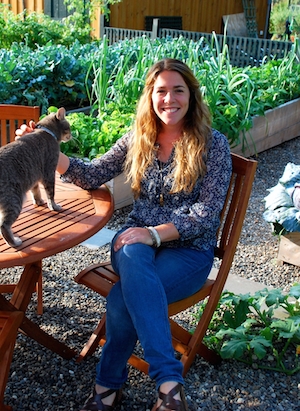Considerations for when you reach business expansion crossroads
By Michelle Sutton

“In business, growth is imperative, not optional.” This is a pervasive theme in the business world, but it’s ok to question it. A few years into my landscaping business of 10 years, I started turning away work because, above all, I wanted to keep the simple business model that made me happy. I did not want to grow just for the sake of growing. Every small business owner has to assess what level of growth will make him or her financially secure, but, just as important, happy and fulfilled. Here are some things to consider when you find yourself at a business-expansion crossroads.
Seven years of Bloom
Liz Elkin began Bloom Landscape and Fine Gardening Service in 2008 in New Paltz, N.Y. Her background was in organic gardening and farming, permaculture, and landscape design, and in the environmentally conscious college town of New Paltz, her interests aligned with those of her future clients. “When I started Bloom, it was just me, my favorite Japanese gardening knife, a passion for plants, and a vision,” Elkin said. Bloom got off to a great start, and business picked up fast.
Within a few months, Elkin enlisted a friend to work with her to keep up with new garden accounts. After the first year, it was very clear that Bloom needed to start bringing on more people, so Elkin hired one crew of three full-time gardeners. The following year, business was booming and Bloom purchased a company van to transport crew and tools from site to site. Every year since, Bloom has added another crew or a vehicle, usually in the spring.
At the start of the 2015 season, Bloom had five vans and five crews of varying sizes working at different accounts. In addition to field crews, Elkin brought on full-time office staff, including an office manager, an operations manager, and a landscape architect. “They are all a great help in keeping all the wheels spinning!” she said.
When asked about what rate of growth makes her happy, Elkin replied, “That is a great question, and one that is most definitely a moving target. The rate of growth that makes me happy correlates directly with the strength of the entire Bloom team. Business growth and expansion becomes more feasible when your staff is capable and dedicated. It’s the collective efforts of every employee, including the owner, that determine how the business thrives.”
Elkin recommends small business owners work hard to surround themselves with the best people they can find. “Put the effort into finding great field crews and office staff that you can trust,” she said. “They are the people who make your business run smoothly on a daily basis. Without solid managers, you have to be in too many places at once, and end up limited to only what one person can do daily.”
Above Cayuga’s waters: finances

After earning his degree in landscape architecture from Cornell University in 1978, David Fernandez immediately registered the name Cayuga Landscape in reference to the nearby lake in central New York. “It was an exciting time,” said Fernandez, “though I made the classic small businessperson’s mistake of not charging nearly enough, even though I had taken business management classes while at Cornell. Eventually I raised my rates and, fortunately, clients stuck with us. We’ve had many of the same clients since those early days.”
Another thing that Fernandez said helped the financial side of things was that he spent very little money on himself in the early years. “I got married when I was 42, so for the first 15 years of Cayuga Landscape, I put everything into the business,” he said. By living simply and below his means, he was able to use his own money to pay bills until clients paid him, until eventually he developed his own working capital.
Cayuga Landscape grew very quickly in its first 10 years. At year 10, Fernandez had a summer staff of approximately 60 people (right now the summer staff is about 50). “Growing quickly means enormous stress and strain on your cash flow,” said Fernandez. “For one thing, your clients pay you monthly, but your staff needs to be paid weekly. When you’re growing, you have new materials to buy and new worker wages to pay, yet you only have the money you received from the smaller volume of business in the past.”
Happily, Fernandez was able to set up an excellent operating line of credit with Farm Credit East, an option that was available after they branched into nursery production. “Farm credit services understand growing operations and are more willing to extend loans for nursery operations than most other lenders,” he said. Regardless of the funding source, Fernandez recommends that new business owners get an early start developing credit.
Fernandez suggests that before you expand; make sure you have good supplier credit in place. “It helps a lot if you don’t have to pay your bills right away,” he said. “When our business was young, we would talk to suppliers who would partner with us to give us extended credit terms, like 60 days with no interest; by then you’re more likely to have been paid by customers. Some of those terms we still enjoy today.”
In addition to trying to extend terms with suppliers, Fernandez recommends you try to quicken the terms with your customers so they pay sooner. For example, by collecting a deposit at the time of contract signing. (However, in some states, such as New York, these funds must be held in escrow until each unit of work is completed. Cayuga Landscape never takes deposits for that reason.) What Fernandez does is bill by units of work. So if it’s a $10K project, he’ll break the work down into five units that can be billed. So, for a patio project, demo and excavation would be the first phase, soil preparation is a second phase, planting is another phase, etc. “We bill for each unit the day after we finish the work and ask to be paid within seven days,” he said.
Then there’s the question of inventory management. A “just-in-time” approach to inventory is best, said Fernandez. Get what you need just when you need it, and only buy what you need.
“When you have more capital, it may make sense to buy large quantities of trees, bricks, mulch etc. at a lower unit price. But if you’re short on cash flow, it makes more sense to use just-in-time inventory management.”
Above Cayuga’s waters: people
Many of the crew leaders have been with Cayuga Landscape for a long time — 15 to 30 years. “Having a lot of continuity like that, and such excellent staff who have the institutional memory for how to do things, makes things go so much more smoothly in a business,” said Fernandez. Try to hang onto those people.
Another consideration when growing is how to integrate new people effectively and safely. “Even if a new hire comes in having said they already know how to do everything, we have them work with one of our experienced crew leaders, and we make sure they can’t jump on a machine until they’ve been trained and checked out by a senior person,” said Fernandez.
Fernandez advises that when considering growth, you keep a sensible ratio between the different parts of your staff. You can’t just increase sales staff and be successful in landing more jobs if you don’t also increase trucks and equipment, build crews, and have more office staff to send bills out promptly. “The ratio of support to field staff has to be right,” he said.
Also, in terms of deciding what jobs to take, Fernandez said it’s important to be selective. Are the jobs more likely to be riskier than normal in financial terms? Are they at a great distance away and not close to any other clients, so the travel will decrease efficiencies? “We try to focus on a core market area geographically and on the things we do the best and most easily,” said Fernandez. “It is critical for your reputation to be able to provide your client with high-quality and timely work, so we are cautious about taking on too many technically challenging jobs in the same season.”
Are these bids for big jobs that will take place at the same time as other large contracts you already have? “If we already have a big job for fall of 2016, for instance,” Fernandez said, “I’ll bid any other potential jobs high to make sure we would meet the extra startup costs for extra staff, etc. If we don’t get the bid, that’s fine, we have enough work. Be careful with what work you take on; take work that’s closer, easier, and well-timed/spaced out.”
Fernandez acknowledged that sometimes he can’t control the variables as precisely as he would like. He said that one of the most aggravating things is when you think your business is expanding in the springtime, but then you hit a slow time in the summer and you’re trying to figure out what to do with the staff. He said, “You have to make sure your expansion is not just to serve a short spring busy period, or else it’ll kill you in terms of labor costs in summer if there’s not enough income coming in.”
Fernandez cautions that it’s especially dangerous when the opportunity to expand into a second location presents itself. Let’s say a fellow landscaper hangs it up — it’s tempting to take on their site. “If you’re a small business it’s tough to run two locations,” said Fernandez. “That needs to be undertaken very carefully because you can end up not doing anything well because your time is divided. Also it takes a lot of capital to take on a second location, and people often underestimate the management time required for it.”
Cayuga Landscape grows at a moderate pace, not more than a few percent per year, like tree rings. “For our core staff and our facilities, this is the right amount of business for us,” said Fernandez.
Michelle Sutton (michellejudysutton.com) is a horticulturist, editor, and freelance writer living in New Paltz, New York.
A heralded book came out in 2014 about this subject, Tree-Ring Management: Take the Long View and Grow Your Business Slowly, by Kiroshi Tsukakoshi (author) and Hart Larrabee (translator).
Top photo: A Bloom Landscape contemporary design.
Photo by Larry Decker



